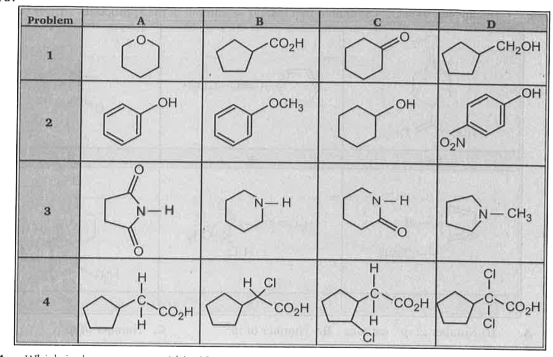Which is strongest base
NH3
PH3
AsH3
SbH3
The correct Answer is:A
To determine which of the given compounds is the strongest base among NH3 (ammonia), PH3 (phosphine), ASH3 (arsine), and SbH3 (stibine), we can analyze the basicity of these compounds based on the properties of their central atoms and the lone pair of electrons they possess.
1. Identify the Compounds:
We have four hydrides:
- NH3 (Ammonia)
- PH3 (Phosphine)
- ASH3 (Arsine)
- SbH3 (Stibine)
2. Understand Basicity:
Basicity refers to the ability of a compound to donate a lone pair of electrons to a proton (H+). The stronger the base, the more readily it can donate its lone pair.
3. Consider the Central Atom:
The central atom in these compounds is nitrogen for NH3, phosphorus for PH3, arsenic for ASH3, and antimony for SbH3. As we move down the group from nitrogen to antimony, the size of the central atom increases.
4. Effect of Atomic Size on Basicity:
As the size of the central atom increases:
- The orbitals become more diffuse.
- The lone pair of electrons becomes less concentrated and less available for donation.
- This results in a decrease in basicity.
5. Compare Basicity:
- NH3 has a small central atom (N) with a concentrated lone pair, making it a strong base.
- PH3 has a larger central atom (P), leading to a decrease in basicity compared to NH3.
- ASH3 and SbH3 have even larger central atoms (As and Sb, respectively), further decreasing their basicity.
6. Conclusion:
Based on the above analysis, NH3 is the strongest base among the given options because it has a concentrated lone pair that is readily available for donation compared to the other hydrides.
Final Answer:
NH3 (Ammonia) is the strongest base among NH3, PH3, ASH3, and SbH3.
We have four hydrides:
- NH3 (Ammonia)
- PH3 (Phosphine)
- ASH3 (Arsine)
- SbH3 (Stibine)
Basicity refers to the ability of a compound to donate a lone pair of electrons to a proton (H+). The stronger the base, the more readily it can donate its lone pair.
The central atom in these compounds is nitrogen for NH3, phosphorus for PH3, arsenic for ASH3, and antimony for SbH3. As we move down the group from nitrogen to antimony, the size of the central atom increases.
As the size of the central atom increases:
- The orbitals become more diffuse.
- The lone pair of electrons becomes less concentrated and less available for donation.
- This results in a decrease in basicity.
- NH3 has a small central atom (N) with a concentrated lone pair, making it a strong base.
- PH3 has a larger central atom (P), leading to a decrease in basicity compared to NH3.
- ASH3 and SbH3 have even larger central atoms (As and Sb, respectively), further decreasing their basicity.
Based on the above analysis, NH3 is the strongest base among the given options because it has a concentrated lone pair that is readily available for donation compared to the other hydrides.
NH3 (Ammonia) is the strongest base among NH3, PH3, ASH3, and SbH3.
Topper's Solved these Questions
- P-BLOCK GROUP 15 ELEMENTS - THE NITROGEN FAMILYBOOK - CENGAGE CHEMISTRY ENGLISHCHAPTER - P-BLOCK GROUP 15 ELEMENTS - THE NITROGEN FAMILYEXERCISE - Exercises (Integer)
20 Videos
- P-BLOCK GROUP 15 ELEMENTS - THE NITROGEN FAMILYBOOK - CENGAGE CHEMISTRY ENGLISHCHAPTER - P-BLOCK GROUP 15 ELEMENTS - THE NITROGEN FAMILYEXERCISE - Exercises (Fill In The Blanks)
15 Videos
- P-BLOCK GROUP 15 ELEMENTS - THE NITROGEN FAMILYBOOK - CENGAGE CHEMISTRY ENGLISHCHAPTER - P-BLOCK GROUP 15 ELEMENTS - THE NITROGEN FAMILYEXERCISE - Exercises (Multiple Correct)
12 Videos
- ORGANIC COMPOUNDS WITH FUNCTIONAL GROUPBOOK - CENGAGE CHEMISTRY ENGLISHCHAPTER - ORGANIC COMPOUNDS WITH FUNCTIONAL GROUPEXERCISE - Archives Analytical And Descriptive
24 Videos
- P-BLOCK GROUP 16 ELEMENTS - THE OXYGEN FAMILYBOOK - CENGAGE CHEMISTRY ENGLISHCHAPTER - P-BLOCK GROUP 16 ELEMENTS - THE OXYGEN FAMILYEXERCISE - Archives Subjective
10 Videos
Similar Questions
Knowledge Check

Which is the strongest acid in 1?AABBCCDD
Which is the strongest acid in 2 ?AABBCCDD
Which is the strongest acid in 4 ?AABBCCDD
The equilibrium constant for the given reaction is approximately 10−3
HPO2−4(aq)+HCO−3(aq)⇔H2PO−4(aq)+CO2−3(aq)
Which is strongest conjugate base in the given reaction?
View SolutionThe equilibrium constant for the given reaction is approximately 10−3
HPO2−4(aq)+HCO−3(aq)⇔H2PO−4(aq)+CO2−3(aq)
Which is strongest conjugate base in the given reaction?
View SolutionWhich is the strongest acid in the following ?
View SolutionWhich is the strongest Lewis acid?
View SolutionWhich is the strongest cartilage ?
View Solution
